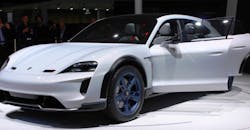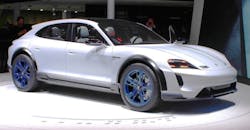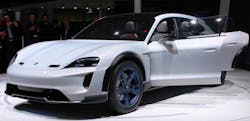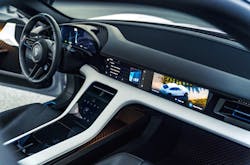At the recent Geneva Motor Show, Porsche christened its electrically-powered Mission E Cross Turismo a “Cross-Utility Vehicle.” You could consider this concept vehicle as Porsche’s version of an SUV. Its demand-controlled all-wheel drive can accelerate from 0 to 100 kmh in 3.5 sec. and 0 to 200 kmh in <12 sec.
The 800V architecture in this concept vehicle ensures that its lithium-ion battery is charged for an NEDC range of approximately 250 miles (400 kilometers) in around 15 minutes. The New European Driving Cycle (NEDC) is a driving cycle, last updated in 1997, designed to assess the emission levels of car engines and fuel economy in passenger cars. It is also referred to as MVEG cycle (Motor Vehicle Emissions Group). Although originally designed for gasoline-based road vehicles, the driving cycle is now also used for diesel vehicles and to estimate the electric power consumption and driving range of hybrid and battery electric vehicles.
Porsche’s electrically-powered Mission E Cross Turismo.
The vehicle allows flexible charging both on the move and at home, and is compatible with the fast-charging network that is being established on European roads as part of the IONITY. This is a joint venture with the mission to build a pan-European high-power-charging (HPC) network for electric vehicles to facilitate long-distance travel. It was founded by the BMW Group, Daimler AG, Ford Motor Company, Volkswagen Group, Audi, and Porsche, but other automotive manufacturers are invited to help expand the network.
At home or in the workplace, the Mission E Cross Turismo can be charged via induction technology, and additionally at home with a charging dock that can work in conjunction with the Porsche home energy management system. The latter option can be combined with the home’s own photovoltaic system to recharge using solar energy. The “E” in the “Porsche” lettering pulsates when the vehicle is charging, and the circuit paths illuminate, giving customers a tangible sense of the energy flow.
Two synchronous electric motors with a system output of over 600 hp (440 kW) accelerate the Mission E Cross Turismo to 100 kmh (62 mph) in less than 3.5 sec. and to 200 kmh (124 mph) in under 12 sec. This performance is in addition to a continuous power level that allows for multiple launches in succession without losing performance, which is unprecedented among electric vehicles. Demand-controlled all-wheel drive with Porsche Torque Vectoring, automatically distributes torque to the individual wheels and transfers the power to the road.
Matrix Design LED headlights represent another style highlight. The typical Porsche four-point daytime running lights have been developed into narrow, three-dimensional glass elements. Embedded in four floating fenders, these lights also feature the new four-point turn signal.
The instrument panel emphasizes the width of the vehicle with a wing-shaped top and bottom section. The dashboard has a clear horizontal arrangement with a wide display for the driver and front passenger. The free-standing instrument cluster is curved and angled toward the driver and consists of three circular display fields, digitally displayed on TFT screens.
The instrument cluster has virtual fields assigned to the categories of Porsche Connect, Performance, Drive, Energy, and Sport Chrono. Using a camera in the interior mirror, the eye-tracking system can recognize where the driver is looking. The displays that the driver is interested in are then moved to the foreground, while the others are reduced into the background accordingly as a result of looking away from them. The displays are operated using smart-touch controls on the steering wheel. A head-up display optimally positioned in the driver’s field of vision enhances the driving experience.
The passenger display screen extends over the entire width of the passenger side. The passenger can operate various apps via eye tracking and touch technology, allowing access to functions like media, navigation, climate control, and contacts. A touch control field in the center console features detailed information menus.
Small touchscreens are situated in the multifunctional window panels (for seat adjustment and seat comfort functions) as well as in the finless air vents on the right and left of the dashboard. By swiping left and right on these touchscreens, the ventilation strength can be adjusted. The “smart cabin” approach simplifies operation. The vehicle settings, interior climate, and ambient lighting are all automatically adjusted to the wishes of the occupants and the respective driving situation.
The driver can also access a variety of information and adjust settings away from the vehicle: Customization options from the air-conditioning system to navigation can be set in advance via a tablet, smartphone, or smartwatch.
The design elements in the interior also include visible lightweight structures, such as the dashboard and the sporty seats reminiscent of bucket-type racing seats, which feature illuminated Porsche lettering. The door panels have 3D elements with a structured surface. Anodized trim pieces in Nordic Blue around the air vents and the window switches provide a contrast to the black Aniline leather and Light Grey two-tone interior.
The Mission E Cross Turismo’s instrument cluster.
“DestinationsApp”: A Personal Travel Assistant
Porsche Connect already offers more than 20 digital services and apps. In the Mission E Cross Turismo, Porsche is adding another called the “DestinationsApp,” which demonstrates additional benefits the digital platform could offer in the near future. Using this app, a weekend trip can be planned quickly and easily in just a few steps on a smartphone. The app suggests travel destinations, enables reservations to be made quickly and effortlessly, and handles route planning. The driver can even tailor the chassis of the Mission E Cross Turismo to the selected route via the “DestinationsApp,” as well as choosing the most suitable music, climate control, and ambient lighting for the journey.
About the Author

Sam Davis
Sam Davis was the editor-in-chief of Power Electronics Technology magazine and website that is now part of Electronic Design. He has 18 years experience in electronic engineering design and management, six years in public relations and 25 years as a trade press editor. He holds a BSEE from Case-Western Reserve University, and did graduate work at the same school and UCLA. Sam was the editor for PCIM, the predecessor to Power Electronics Technology, from 1984 to 2004. His engineering experience includes circuit and system design for Litton Systems, Bunker-Ramo, Rocketdyne, and Clevite Corporation.. Design tasks included analog circuits, display systems, power supplies, underwater ordnance systems, and test systems. He also served as a program manager for a Litton Systems Navy program.
Sam is the author of Computer Data Displays, a book published by Prentice-Hall in the U.S. and Japan in 1969. He is also a recipient of the Jesse Neal Award for trade press editorial excellence, and has one patent for naval ship construction that simplifies electronic system integration.
You can also check out his Power Electronics blog.





